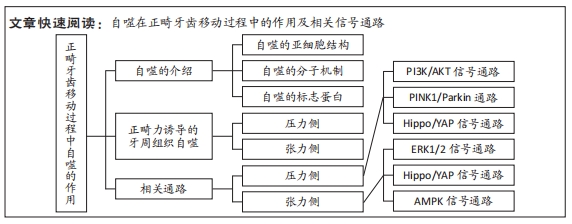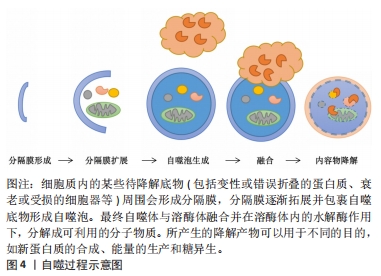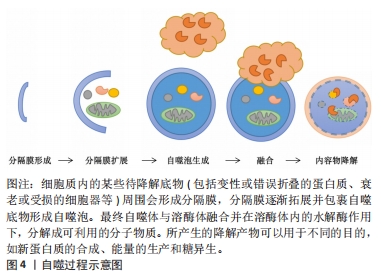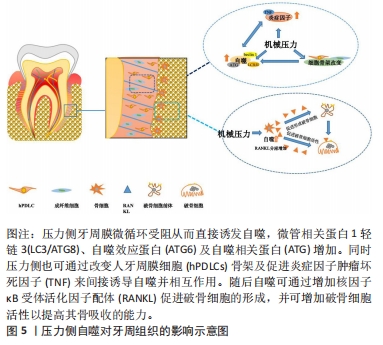[1] LI Y, ZHAN Q, BAO M, et al. Biomechanical and biological responses of periodontium in orthodontic tooth movement: up-date in a new decade. Int J Oral Sci. 2021;13(2):129-147.
[2] ELSHAZLY TM, BOURAUEL C, ALDESOKI M, et al. Computer-aided finite element model for biomechanical analysis of orthodontic aligners. Clin Oral Investig. 2023;27(1):115-124.
[3] SAMARE-NAJAF M, NEISY A, SAMAREH A, et al. The constructive and destructive impact of autophagy on both genders’ reproducibility, a comprehensive review. Autophagy. 2023;19(12):3033-30611.
[4] YOUNG SP, SEUNG HC, HWUN KC, et al. Inactivation of PI3K/Akt promotes the odontoblastic differentiation and suppresses the stemness with autophagic flux in dental pulp cells. J Dent Sci. 2022;17(1):145-154.
[5] LIU LL, LI XJ, BU WH, et al. Carbon dots enhance extracellular matrix secretion for dentin-pulp complex regeneration through PI3K/Akt/mTOR pathway-mediated activation of autophagy. Mater Today Bio. 2022;16:100344.
[6] WANG Q, LIU J, YANG XM, et al. Gold nanoparticles enhance proliferation and osteogenic differentiation of periodontal ligament stem cells by PINK1-mediated mitophagy. Arch Oral Biol. 2023;150:105692.
[7] 宋璐,谭静怡,陈莉丽.自噬及其相关蛋白在牙周病发生发展中作用的研究进展[J].中华口腔医学杂志,2019,54(5):339-343.
[8] IVAN D, ZVULUN E. Mechanism and medical implications of mammalian autophagy. Nat Rev Mol Cell Biol. 2018;19(6):349-364.
[9] SVENJA M, ANNA D, BEATRICE W, et al. Autophagy in periodontal ligament fibroblasts under biomechanical loading. Cell Tissue Res. 2019;378(3):499-511.
[10] XU J, ZHAO X, ZENG J, et al. Role of autophagy in the periodontal ligament reconstruction during orthodontic tooth movement in rats. J Dent Sci. 2020; 15(3):351-363.
[11] JIANG YK, HU ZA, GUAN YZ, et al. Research progress in mechanotransduction process of mechanical-stress-induced autophagy. Sichuan Da Xue Xue Bao Yi Xue Ban. 2021;52(6):929-935.
[12] DE DUVE C, WATTIAUX R. Functions of lysosomes. Annu Rev Physiol. 1966;28: 435-492.
[13] ARSTILA AU, TRUMP BF. Studies on cellular autophagocytosis. The formation of autophagic vacuoles in the liver after glucagon administration. Am J Pathol. 1968;53(5):687-733.
[14] KLIONSKY DJ, CREGG JM, DUNN WA JR, et al. A unified nomenclature for yeast autophagy-related genes. Dev Cell. 2003;5(4):539-545.
[15] KING JS, VELTMAN DM, INSALL RH. The induction of autophagy by mechanical stress. Autophagy. 2011;7(12):1490-1499.
[16] 周云.正畸牙齿移动过程中牙周膜成纤维细胞自噬作用的初步研究[D].西安:第四军医大学,2014.
[17] LI Y, JACOX LA, COATS S, et al. Roles of autophagy in orthodontic tooth movement. Am J Orthod Dentofacial Orthop. 2021;159(5):582-593.
[18] STOJANOVIC O, MIGUEL-ALIAHA I, TRAJKOVSKI M. Intestinal plasticity and metabolism as regulators of organismal energy homeostasis. Nat Metab. 2022; 4(11):1444-1458.
[19] CAO WY, LI JH, YANG KP, et al. An overview of autophagy: mechanism, regulation and research progress. Bull Cancer. 2021;108(3):304-322.
[20] LIU XC, LU JJ, CHEN YM, et al. Roles of autophagy onself-renewal and differentiation of mesenchymal stem cells. West Chin J Stomatol. 2020;38(6):704-707.
[21] SUN YN, WANG HH, QU TQ, et al. mTORC2: a multifaceted regulator of autophagy. Cell Commun Signal. 2023;21(1):4.
[22] TU CF, LI HY, LIU XY, et al. TDRD7 participates in lens development and spermiogenesis by mediating autophagosome maturation. Autophagy. 2021; 17(11):3848-3864.
[23] ALEX P, LOREDANA B, SABRINA C, et al. Combined inhibition of Hedgehog and HDAC6: in vitro and in vivo studies reveal a new role for lysosomal stress in reducing glioblastoma cell viability. Int J Mol Sci. 2023;24(6):5771.
[24] HAN RH, HUANG HM, HAN H, et al. Propofol postconditioning ameliorates hypoxia/reoxygenation induced H9c2 cell apoptosis and autophagy via upregulating forkhead transcription factors under hyperglycemia. Mil Med Res. 2021;8(1):58.
[25] KLIONSKY DJ, PETRONI G, AMARAVADI RK, et al. Autophagy in major human diseases. EMBO J. 2021;40(19):e108863.
[26] LÖRINCZ P, JUHAÁSZ G. Autophagosome-Lysosome fusion. J Mol Biol. 2020; 432(8):2462-2482.
[27] SAWA-MAKARSKA J, BAUMANN V, COUDEVYLLE N, et al. Reconstitution of autophagosome nucleation defines Atg9 vesicles as seeds for membrane formation. Science. 2020;369(6508):eaaz7714.
[28] TIAN W, ALSAADI R, GUO Z, et al. An antibody for analysis of autophagy induction. Nat Methods. 2020;17(2):232-239.
[29] MARINÕ G, NISO-SANTANO M, BAEHRECKE EH, et al. Self-consumption: the interplay of autophagy and apoptosis. Nat Rev Mol Cell Biol. 2014;15(2):81-94.
[30] SHIM MS, LITON PB. The physiological and pathophysiological roles of the autophagy lysosomal system in the conventional aqueous humor outflow pathway: More than cellular clean up. Prog Retin Eye Res. 2022;90:101064.
[31] MALTHA JC, KUIJPERS-JAGTMAN AM. Mechanobiology of orthodontic tooth movement: an update. J World Fed Orthod. 2023;12(4):156-160.
[32] 徐洁.周期性压力激活人牙周膜细胞自噬的分子机制初步研究[C].2020年中华口腔医学会口腔生物医学专业委员会第十次全国口腔生物医学学术年会暨第六次全国口腔杰青优青论坛论文汇编,2020:46-47.
[33] SCHROÖDER A, BAUER K, SPANIER G, et al. Expression kinetics of human periodontal ligament fibroblasts in the early phases of orthodontic tooth movement. J. Periodontal Res. 2018;79:337-351.
[34] LV JL, XU J, ZENG J, et al. Expression of autophagy-related protein Beclin-1 and microtubule-associated protein 2 light chain 3 in periodontal ligament cells in orthodontic tooth pressure areas. West Chin J Stomatol. 2019;37(2):168-173.
[35] 尹圆圆,马华钰,李昕怡,等.小鼠正畸牙移动中牙周组织自噬相关基因表达的初步研究[J].国际口腔医学杂志,2020,47(6):627-634.
[36] LI WL, ZHAO J, SUN W, et al. Osteocytes promote osteoclastogenesis via autophagy-mediated RANKL secretion under mechanical compressive force. Arch Biochem Biophys. 2020;694:108594.
[37] HUI JY,BING L,QIONG W, et al. Echinocystic acid inhibits RANKL-induced osteoclastogenesis by regulating NF-κB and ERK signaling pathways. Biochem Biophys Res Commun. 2016;477(4):673-677.
[38] SHOJI-MATSUNAGA A, ONE T, HAYASHI M, et al. Osteocyte regulation of orthodontic force-mediated tooth movement via RANKL expression. Sci Rep. 2017;7(1):8753.
[39] MONTASERI A, GIAMPIETRI C, ROSSI M, et al. The role of autophagy in osteoclast differentiation and bone resorption function. Biomolecules. 2020;10(10):1398.
[40] 杨玉婷.1.LPS介导自噬下调Wnt通路促破骨细胞生成的研究2.GTR联合植骨术治疗下颌第二磨牙远中骨缺损[D].杭州:浙江大学,2021.
[41] CAI SZ, CHEN YY, CHEN JW, et al. Rubiadin-1-methyl ether inhibits BECN1 transcription and Beclin1-dependent autophagy during osteoclastogenesis by inhibiting NF-κB p65 activation. Exp Biol Med. 2023;248(17):1518-1526.
[42] ZHU L, WANG JH, WU ZP, et al. AFF4 regulates osteogenic potential of human periodontal ligament stem cells via mTOR-ULK1-autophagy axis. Cell Prolif. 2023. doi: 10.1111/cpr.13546.
[43] ZHU WY, DONG WR, ZHANG SS, et al. Alterations between autophagy and apoptosis in alveolar bone mesenchymal stem cells under orthodontic force and their effects on osteogenesis. J Hard Tissue Biol. 2022;31(3):147-154.
[44] D’ARCY MS. Cell death: a review of the major forms of apoptosis, necrosis and autophagy. Cell Biol Int. 2019;43(6):582-592.
[45] WANG MY, ZHANG L, LIN F, et al. Dynamic study into autophagy and apoptosis during orthodontic tooth movement. Exp Ther Med. 2021;21(5):430.
[46] SUN YQ, FU JF, LIN FR, et al. Force-induced nitric oxide promotes osteogenic activity during orthodontic tooth movement in mice. Stem Cells Int. 2022;2022: 4775445.
[47] ZHENG JY, XU BW, YANG K. Autophagy regulates osteogenic differentiation of human periodontal ligament stem cells induced by orthodontic tension. Stem Cells Int. 2022;2022:2983862.
[48] MEMMERT S, NOGUEIRA AVB, DAMANAKI A, et al. Regulation of the autophagy-marker Sequestosome 1 in periodontal cells and tissues by biomechanical loading. J Orofac Orthop. 2020;81(1):10-21.
[49] CHEN LY, MO SZ, HUA YM. Compressive force-induced autophagy in periodontal ligament cells downregulates osteoclastogenesis during tooth movement. J Periodontol. 2019;90(10):1170-1181.
[50] JACOX LA, TANG N, LI Y, et al. Orthodontic loading activates cell-specific autophagy in a force-dependent manner. Am J Orthod Dentofacial Orthop. 2022; 161(3):423-436.e1.
[51] ZHOU ZZ, SSHI GX, ZHENG XF, et al. Autophagy activation facilitates mechanical stimulation-promoted osteoblast differentiation and ameliorates hindlimb unloading-induced bone loss. Biochem Biophys Res Commun. 2018;498(3):667-673.
[52] WANG J, ZHANG Y, CAO J, et al. The role of autophagy in bone metabolism and clinical significance. Autophagy. 2023;19(9):2409-2427.
[53] CITA N, JOSEF L, MARCOS LG, et al. Mechanical-induced bone remodeling does not depend on Piezo1 in dentoalveolar hard tissue. Sci Rep. 2023;13(1):9563.
[54] YANG YQ, LIU Q, LU X, et al. Sanhuang decoction inhibits autophagy of periodontal ligament fibroblasts during orthodontic tooth movement by activating PI3K-Akt-mTOR pathway. Biomed Pharmacother. 2023;166:115391.
[55] PAN ZB, TAN ZM, LI HY, et al. Diosmetin induces apoptosis and protective autophagy in human gastric cancer HGC-27 cells via the PI3K/Akt/FoxO1 and MAPK/JNK pathways. Med Oncol. 2023;40(11):319.
[56] XU Y, SHEN J, MUHAMMED FK, et al. Effect of orthodontic force on the expression of PI3K, Akt, and P70S6 K in the human periodontal ligament during orthodontic loading. Cell Biochem Funct. 2017;35(7):372-377.
[57] HUANG YP, LIU H, GUO RZ, et al. Long Non-coding RNA FER1L4 mediates the autophagy of periodontal ligament stem cells under orthodontic compressive force via AKT/FOXO3 pathway. Front Cell Dev Biol. 2021;9:631181.
[58] JIANG N, HE DQ, MA YS, et al. Force-induced autophagy in periodontal ligament stem cells modulates M1 macrophage polarization via AKT signaling. Front Cell Dev Biol. 2021;9:666631.
[59] SU L, ZANG JH, GOMEZ H, et al. Mitochondria ROS and mitophagy in acute kidney injury. Autophagy. 2023;19(2):401-414.
[60] FAN ZB, JIN K, LI SH, et al. Regulation of reactive oxygen species on the mitophagy of human periodontal ligament cells through the PINK1/Parkin pathway under starvation. West Chin J Stomatoli. 2022;40(6):645-653.
[61] PICCOLO S, DUPONT S, CORDENONSI M. The biology of YAP/TAZ: hippo signaling and beyond. Physiol Rev. 2014;94(4):1287-1312.
[62] SUN BY, WEN Y, WU X, et al. Expression pattern of YAP and TAZ during orthodontic tooth movement in rats. J Mol Histol. 2018;49(2):123-131.
[63] 伍宇婕,晚晓芳,魏绵兴,等.正畸牙移动模型小鼠压力侧牙周膜细胞自噬与Hippo-Yes相关蛋白通路的关系[J].中国组织工程研究,2023,27(5):683-689.
[64] PARK KR, LEE JY, CHO M, et al. Ziyuglycoside I upregulates RUNX2 through ERK1/2 in promoting osteoblast differentiation and bone mineralization. Am J Chin Med. 2021;49(4):883-900.
[65] 张闵,白书林,李胜鸿,等.高迁移率族蛋白B1及ERK1/2通路对张应力下人牙周膜细胞自噬的影响[J].中国组织工程研究,2023,27(10):1560-1566.
[66] 宋京,任大鹏,颜世果,等.细胞外信号调节蛋白激酶1/2在介导周期性牵张力对牙周膜细胞成骨分化中的作用[J].华西口腔医学杂志,2017,35(5):520-526.
[67] 晚晓芳,何海燕,吕佳岭,等.周期性张应力作用下Hippo-YAP信号通路调控人牙周膜细胞自噬[J].华西口腔医学杂志,2023,41(3):260-268.
[68] 李炎杰,刘旺,和红兵.AMPK通路介导骨代谢相关细胞自噬调控牙周炎骨稳态的研究进展[J].口腔疾病防治,2023,31(7):524-528.
[69] XU HY, XIA M, SUN L, et al. Osteocytes enhance osteogenesis by autophagy-mediated FGF23 secretion under mechanical tension. Front Cell Dev Biol. 2022; 9:782736.
[70] HU R, WANG MQ, LIU LY, et al. Calycosin inhibited autophagy and oxidative stress in chronic kidney disease skeletal muscle atrophy by regulating AMPK/SKP2/CARM1 signalling pathway. J Cell Mol Med. 2020;24(19):11084-11099.
[71] LIN ZQ, ZHOU ZP, VON GISE AG, et al. Pi3kcb links Hippo-YAP and PI3K-AKT signaling pathways to promote cardiomyocyte proliferation and survival. Circ Res. 2015;116(1):35-45.
[72] 徐珮琼,郑治国,伍军.正畸牙移动中脂联素调控PI3K/AKt信号通路对牙周组织改建的影响[J].中国临床解剖学杂志,2023,41(5):583-587.
[73] 刘安琪.Gli1+细胞在正畸牙移动中的作用研究[D].西安:中国人民解放军空军军医大学,2020.
[74] 王玥.机械压力调控破骨细胞分泌miR-146a-5p促进血管形成并影响正畸骨改建的作用和机制研究[D].北京:北京大学医学部,2021.
[75] 宋吉玉.杜仲皮纯化多糖通过ERK/BMP-2/Smad通路促进成骨分化抗骨质疏松作用研究[D].长春:吉林大学,2023.
[76] 林维龙,吴晓沛,何薇薇,等.重组人转化生长因子β1对大鼠正畸牙移动模型成骨细胞分化及ERK/MAPK信号通路的影响[J].口腔医学研究,2023, 39(2):118-123. |








